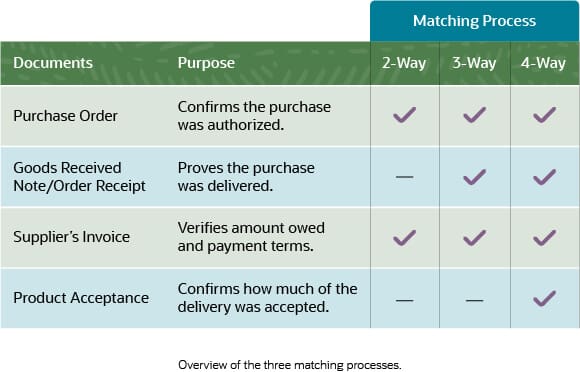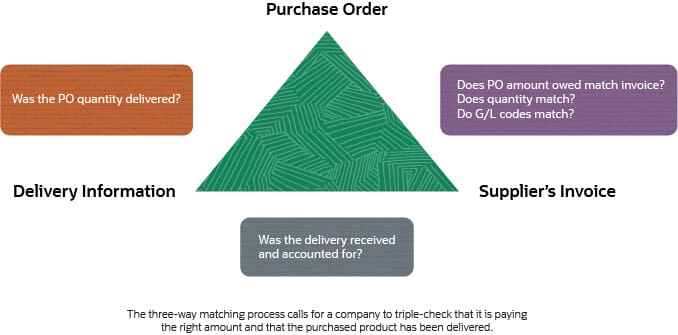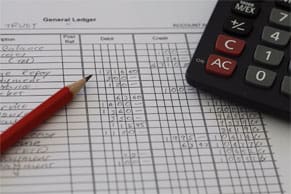In the world of accounts payable (AP), one of the most challenging jobs is managing the onslaught of supplier invoices that arrive each month. This includes verifying that the invoices are real — small businesses experience billing fraud twice as often as their larger counterparts, according to an Association of Certified Fraud Examiners (ACFE) report — and then paying the ones that are. One technique AP teams use to make sure invoices are legitimate is called three-way matching. In addition to picking up on criminal activities, three-way matching can benefit an organization in other ways, especially when the process is automated.
What Is Three-Way Matching?
Three-way matching is an AP invoice process that determines whether a supplier invoice should be paid. Simply put, three-way matching entails cross-referencing the invoice with its corresponding purchase order (PO) and delivery receipt to make sure all pertinent details, such as the quoted order amount and the number of items ordered, match. Doing this can help companies root out fake or unauthorized transactions, which can cost a company an estimated 5% of its annual revenue, according to the ACFE report.
Two-way vs. Three-way Matching
Two-way matching compares an invoice only to its PO. As its name implies, three-way matching involves a third step: verification that the purchased product was actually delivered, courtesy of an order receipt or packaging slip.

Key Takeaways
- Three-way matching is an AP process used to verify a supplier invoice by checking it against its corresponding purchase order and order receipt.
- It reduces the chances of fraudulent invoices going undetected and, worse, being paid.
- Companies can set thresholds to determine which invoices require three-way matching.
- An automated system can handle the approval process, saving AP staff time and effort left best to investigating unmatched details.
Three-Way Matching Explained
Three-way matching is an important account control that companies use to make sure invoices are paid only when they are properly validated against two other documents: their POs (issued by someone authorized to do so) and goods received notes, or receipts, that the purchase was delivered to its destination. A PO also lists the quantity of items or services to be purchased and the agreed cost. The delivery receipt verifies that the delivery was made. Three-way matching confirms that the details match each other across all three documents.
These few extra steps can go a long way toward catching the costly problem of invoice fraud. To be sure, invoice fraud can happen to the biggest of organizations: Just a few years ago, for example, Google and Facebook both issued multimillion-dollar payments for fake invoices sent by a cybercriminal in Lithuania. (They recovered their money.) Smaller businesses, however, would be less likely to withstand such a scam.
Video: Three-Way Matching
How Does Three-Way Matching Work?
Three-way matching is a payment verification technique that compares the details associated with a particular purchase across a trio of related documents. Once the information is validated, payment can be sent. If one or more details fail to match, another AP process is triggered to investigate the discrepancies.
Three-Way Matching Components
Simply put, three-way matching requires the details of three pieces of documentation to match. These are the individual documents:
- Purchase order, which authorizes a purchase to be made. It lists the types, quantities and prices of an order, as agreed to by the buyer and supplier. The PO has a unique number that is used for reference and tracking purposes.
- Delivery receipt, or a receiving report, which confirms that the purchase was delivered, either in part or in full.
- Supplier’s invoice, which lists how much the buyer owes the supplier, payment details — such as a payment schedule — and an invoice number.
Three-Way Matching Process
Three-way matching is a straightforward process — that is, an AP clerk compares the three components, listed above. But given the high-volume of purchases at many companies, it can be quite time-consuming, particularly when handled manually. Among the points an AP clerk must check:
- PO verification: Was the purchase order filled out completely, noting the amount to be paid, the name and address of the vendor and any other required internal information? If necessary, are the correct general-ledger (G/L) codes listed?
- Delivery information: Does the quantity ordered on the PO match the quantity delivered, as reported by the receiving or inventory department?
- Supplier’s invoice: Is the supplier seeking payment for the amount authorized on the PO? Further, does the quantity received match the quantity purchased? In other words, if only part of an order was received, is the supplier seeking full or partial payment?
What does the three-way matching process look like in practice? Let’s use the example of a construction company that is building 20 homes for a new community. The company issues a PO to a siding supplier for 12,000 square feet of vinyl siding, at $10 per square foot, to be used throughout the development. Two weeks later, the supplier delivers the siding and sends its invoice to the construction company. The construction company then uses the three-way matching process to verify that the supplier’s invoice amount for $120,000 matches the PO and that the delivery receipt confirms siding was delivered. If only half of the order was delivered, the company may pay part of the invoice or withhold payment until the entire order is fulfilled. If the purchase order, invoice and delivery information match, the company can pay the invoice.

Who Are the Stakeholders in Three-Way Matching?
Depending on the size and scope of the purchasing organization, numerous decision-makers from different departments may be involved in the three-way matching process. These department may include:
- Purchasing/procurement: This department’s stakeholder is responsible for sourcing and buying goods and services on the company’s behalf, whether they’re raw materials for construction or manufacturing projects, office supplies or cloud-based software licenses.
- Receiving/inventory: Employees who work at the company’s receiving dock, where orders are delivered, are responsible for tracking the receipt of a purchase and ensuring that it is stored and inventoried (if appropriate) until needed.
- Finance: The AP team is responsible for paying supplier invoices, but only after matching them against their purchase orders and delivery receipts.
- Supplier/vendor: The vendor’s role is to fulfill the PO, verifying that the correct quantity is delivered at the agreed-on price and at the quality expected.
| Stakeholder | Role | Why Are They a Stakeholder? |
|---|---|---|
| Purchaser | Issues PO stating item requested, quantity and price. | They require the purchased goods for a legitimate business reason. |
| Receiver | Checks quantity delivered. | They track receipt of deliveries. |
| Finance team | Confirms invoice is legitimate and reflects delivery, and then issues payment. | They pay the invoice, verifying its accuracy. |
| Vendor | Fulfills the PO. | They want to be paid for goods provided. |
Benefits of Three-Way Matching for Businesses
There are many benefits for businesses that use three-way matching. Best practices give the ability to:
- Trigger the payment process: For many companies, receipt of an invoice puts the payment process, and three-way matching, in motion. At that point the company will already have the PO and proof that an order was received.
- Catch fraud: Three-way matching serves as a form of checks and balances to make sure an invoice is legitimate. By comparing the three distinct documents — PO, invoice and delivery information — a company can be confident about issuing a payment.
- Save money: In keeping with the previous point, catching fraudulent invoices translates to real dollars saved by not paying a phony supplier. Three-way matching can also help catch discrepancies that might lead to overpayment. When the process is automated, a company may also be able to take advantage of discounts offered for timely payment.
- Improve business relationships: A trusted bond is formed over time when a supplier consistently sends accurate invoices, which leads to a company’s ability to pay the supplier faster. A solid supplier relationship may also result in better pricing and credit terms.
- Be prepared for audit: The documentation that three-way matching process requires also helps a company prepare for internal and external audits.
Disadvantages of Three-Way Matching for Businesses
Despite its many advantages, three-way matching is not without several challenges — which mainly rear their heads when the process is handled manually. Key disadvantages:
- Typically labor-intensive: Three-way matching takes time and a bit of legwork, especially when discrepancies arise. This may result in payment delays that, in turn, rack up late charges and possible ill will with suppliers. Staff would be occupied with the manual matching process rather than activities that add value.
- Hard to handle high volume: Hand in hand with the previous point, AP departments often contend with high volumes of invoices, all of which take time to match and could slow down the payment process. As the saying goes, time is money.
- Can be complex: Although three-way matching is, at its core, a simple process, many variables must be managed, which may lead to complications when making comparisons.
- May not work for services purchases: It’s one thing to account for the delivery of a product. But services tend to be delivered in an ongoing manner, so three-way matching is not always feasible in these cases.
- Fraud still a factor: While three-way matching can help increase the detection of fraudulent invoices, it can’t be expected to entirely eliminate fraud.
- Errors take time to reconcile: When discrepancies occur, they can be tricky to resolve, especially when stakeholders are working from different locations.
- Room for error: From misplacing paperwork, to misreading figures, to misinterpreting agreement terms, any process handled manually is open to human error.
Three-Way Matching Example
Let’s look at a hypothetical example of three-way matching — that of a boutique hotel chain whose marketing department has prepared a new full-color brochure and needs 100,000 copies. Now, it needs to hire a printer, aka the vendor or supplier. After collecting and comparing bids, a printer is selected and the order is placed. At this point, the marketing manager issues a purchase order, which lists the printer’s name, the number of brochures to be delivered, how much the order will cost ($300,000) and expected delivery date, along with any internal accounting expense or project codes and other related information.
The printer, which gladly accepted this lucrative assignment, receives the hotel’s PO along with the digital files needed for printing the brochures. It completes the job in the agreed time frame and delivers the brochures to the receiving address. The printer also sends the hotel its invoice for $300,000. When this invoice is received, the hotel’s AP team sets about to verify its authenticity by using three-way matching.
First, an AP clerk calls up the purchase order to verify that the marketing department was authorized to purchase 100,000 brochures from that vendor. Then the clerk checks that the price for printing the brochures match. The clerk will also verify that the name of the invoicing company matches the name of the company on the purchase order. This is done to make sure the invoice is not a rogue request from a third party trying to be paid for a phony order. Next, the AP rep looks at the delivery logs or memo. They see that 20 pallets of brochures were, in fact, delivered by the printer. Each pallet contains 5,000 brochures, so that matches both the PO quantity and the supplier invoice.
This data provides the AP group with all the correct matching details so they can streamline the AP process, ensuring the invoice is legitimate and ready to be paid.
4 Ways to Make Three-Way Matching More Efficient
To get the most out of three-way matching, it’s important to use it as a policy. Here are some tips about how a company can make three-way matching more efficient.
- Value threshold: A company can stipulate that invoices and purchase orders only over a certain dollar amount are subject to three-way matching. This makes good sense, since unchecked high-value purchases can result in the biggest financial loss.
- Discrepancy threshold: Another way to make three-way matching more efficient is to authorize AP personnel to pay invoices that are within a specified percentage of the purchase order amount. This will account for small discrepancies that might be due to a legitimate charge.
- Vendor rating: Consider rating vendors based on the accuracy of their invoices. The ones that consistently send accurate invoices would be assigned a high rating, which would signal to AP that their future invoices may not need more than periodic spot-checking.
- Process automation: With the right technology in place, a company can automate the entire three-way matching process. In this case, only the discrepancies are brought to AP’s attention.
Why Automate Three-Way Matching? What Are the Benefits?
Speaking of technology, automating the three-way matching process provides a company with numerous benefits. Consider a system in which the details of the purchase order and order delivery are entered into a database. As soon as the vendor invoice is received, all of the information needed to manually conduct the three-way match are accessible. But if vendors send their invoices electronically, directly into the same database, three-way matching can be performed automatically for most invoices.
But the value of three-way matching goes deeper. Such a system would obviously contain vendor information, so the AP team could easily see how many invoices they’ve processed from the same vendor, which can inform the vendor’s rating.
Automating the three-way matching process can save companies time and money, catch fraud and enable AP staff to focus on higher-value projects. Additionally, automation can help an organization capture discounts for timely payments and avoid late fees associated with missing payment deadlines.
Why Is Manual Matching Bad for Businesses?
The costs of manual three-way matching involve more than actual dollars. For the AP department, there’s real stress in having to chase down details generated by poor or misplaced documentation, as well as having to tackle a tall pile of invoices that grows bigger by the day. Human error is another “gotcha.” It’s not hard to imagine the foibles of human error cropping up among the dozens of small details that need to be tracked. Not only does that create more work for the AP team, but they might need to drag the warehouse and procurement managers into the resolution.
Automate Three-Way Matching With Accounting Software
NetSuite Invoice Management simplifies the three-way matching process, and thereby improves a business’s cash flow, by automating the matching of POs, item receipts and vendor invoices. Once a purchase order, order receipt and supplier invoice are entered, the software can quickly determine whether the details align. If they do, an invoice can be scheduled for payment. When they don’t, the system will notify AP, which can then investigate the discrepancies. This functionality is included as part of NetSuite Procurement, which is available as an add-on module to NetSuite ERP.
Conclusion
Companies that use three-way matching can be confident that they’re paying only for authorized, legitimate invoices once a purchase has been delivered. Pertinent details, including supplier name, purchase quantity and cost of purchase, are matched across three related documents: a purchase order, delivery receipt and supplier invoice. While that may sound straightforward, the process can be quite time-consuming if handled manually — and even more so when details don’t align, prompting further investigation. Three-way matching is best handled through automation, freeing workers from a labor-intensive process, quickly catching red flags that may portend invoice fraud and leading to faster payments that make for solid business relationships.
Three-Way Matching FAQs
What is 3-way matching and 2-way matching?
Three-way matching is an accounts payable process that checks that the details on a purchase order, the supplier’s invoice and the delivery receipt match before an invoice is paid. Two-way matching checks only the details of the supplier’s invoice against the details of the purchase order.
What is three-way matching in accounts payable?
Three-way matching is an accounting process that compares what was ordered (the purchase order), what was delivered (receipt) and the supplier’s invoice to verify that an invoice is legitimate and ready to be paid.
Which documents are required for 3-way matching?
Conducting a three-way match requires three documents: the purchase order, the supplier’s invoice and the delivery memo.









